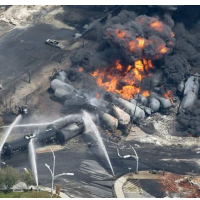Two Bay Area City Councils Oppose Rail Superhighway for Dangerous Crude
 Lac-Mégantic oil tanker explosion July 6, 2013 (photo: Paul Chiasson, Canadian Press/Associated Press)
Lac-Mégantic oil tanker explosion July 6, 2013 (photo: Paul Chiasson, Canadian Press/Associated Press)
Three months after Phillips 66 announced its intention to bring crude oil to its Nipomo Mesa Santa Maria Refinery via train from up north, Bay Area communities in the presumed path of the rail highway have shaken their fists and thrown down the gauntlet.
Whether there is anything they can actually do to stop convoys of 80 train cars or more rattling through the city and countryside, carrying dangerous crude oil from the Bakken Fields of North Dakota and tar sands of Alberta, Canada, remains to be seen.
Earlier in the week, the city councils in Richmond and Berkeley passed similar resolutions condemning the plan to ramp up oil imports for refining at their expense without a lot more review. They pleaded to Congress for help, since much of what the railroads do is under federal purview, and threatened to do whatever they could to hamper Phillips’ plans.
“There are terrible threats in our midst,” Richmond Mayor Gayle McLaughlin said at Tuesday’s city council meeting. “Ultimately, we need to ban it from coming through our community.”
Good luck with that.
But lawsuits, zoning restrictions, opposing permits and political pressure are among the tools local politicians do have. Berkeley Councilman Max Anderson warned of the dangers but acknowledged the odds of success when he said, “We're talking about rendering a large swath of our community uninhabitable and toxic in terms of future generations. What we are doing today is a small effort, but it can grow.”
California is a major refiner of other people’s crude and a net importer. According to the California Energy Commission, the state produces only about 37.2% of the petroleum it uses. But the overwhelming majority of imports have come via ocean transports (two-thirds) and pipeline (one-third). In 2012, only 0.2% of the 598 million barrels of oil arrived by rail.
That is already changing. The commission expects rail to account for a quarter of imports by 2016 as oil production in the West booms and producers look for refiners.
The environmental impact report for the Santa Maria refinery, released last November, detailed construction of rail lines, controlled by Union Pacific Railroad, to accommodate the so-called unit trains. The project description (pdf) said the source of the crude “could include fields as far away as the Bakken field in North Dakota or Canada.”
Phillips 66 has since retracted that statement and said it doesn’t know where the oil will come from.
Where oil comes from matters. Canadian tar sands is the world’s dirtiest petroleum product. Energy companies want to ship it to refineries on the Gulf Coast via the controversial Keystone XL pipeline and California on trains and trucks.
The Bakken oil fields have boomed—thanks to the recent refinement and popularity of hydraulic fracturing (fracking) —reaching oil that could not otherwise be tapped. Bakken oil is considered more dangerous (pdf) to transport than other crude.
The U.S. Pipeline and Hazardous Materials Safety Administration (PHMSA) issued a safety alert on January 2 to “the general public, emergency responders and shippers and carriers that recent derailments and resulting fires indicate that the type of crude oil being transported from the Bakken region may be more flammable than traditional heavy crude oil.”
The agency was responding to an accident just days before near Casselton, North Dakota. A 106-car train derailed, dumped 400,000 gallons of Bakken crude and exploded. Residents evacuated the town of 2,400.
It was the fourth major oil train accident in North America in a six-month period. Last July, a 72-car train derailed in Lac-Mégantic, Quebec, spilling 1.5 million gallons of Bakken crude and killing 47 people.
In noting the volatility of Bakken crude, the PHMSA highlighted the fact that many of today’s tanker cars are ill-equipped to handle their modern loads. Transportation experts warn that aging train cars are susceptible to rupture and puncture in a derailment.
And as Governor Jerry Brown’s proposed 2014-14 budget makes clear, the state is unprepared for an increase in accidents. He asked the Legislature to approve an additional 38 staff members and $6.7 million for the Office of Oil Spill Prevention and Response in the Department of Fish and Wildlife. The office currently employs 245 people.
Railroads are carrying 25 times more crude oil nationally than they were five years ago and the increase is reflected in oil spill incidents. Around 792,600 gallons of oil were spilled in train accidents from 1975 to 2012, according to the PHMSA. That total was nearly doubled in 2013 (1.3 million gallons).
–Ken Broder
To Learn More:
Richmond, Berkeley Councils Vote to Oppose Transport of Highly Flammable Crude Oil Through the East Bay (by Tom Lochner, Robert Rogers and Doug Oakley, Contra Costa Times)
Berkeley, Richmond Fight Crude Oil Rail Shipments (by John Sailors, San Francisco Business Times)
Phillips 66 Rail Project—Explosive Risks Far Outweigh the Benefits (by Linda Reynolds, CalCoast opinion)
East Bay and South Bay Passenger Rail Corridor Proposed to Move Crude Oil (by Tom Lochner, Contra Costa Times)
- Top Stories
- Controversies
- Where is the Money Going?
- California and the Nation
- Appointments and Resignations
- Unusual News
- Latest News
- California Forbids U.S. Immigration Agents from Pretending to be Police
- California Lawmakers Urged to Strip “Self-Dealing” Tax Board of Its Duties
- Big Oil’s Grip on California
- Santa Cruz Police See Homeland Security Betrayal in Use of Gang Roundup as Cover for Immigration Raid
- Oil Companies Face Deadline to Stop Polluting California Groundwater





